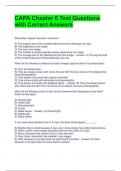Exam (elaborations)
CAPA Chapter 6 Test Questions with Correct Answers
- Course
- Institution
CAPA Chapter 6 Test Questions with Correct Answers What does 'angular resolution' measure? A) The angular size of the smallest features that the telescope can see. B) The brightness of an image. C) The size of an image. D) The number of electromagnetic waves captured by an image. E) The ...
[Show more]



